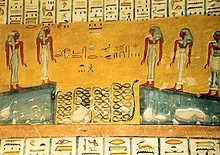Sandbank of Apophis
| Sandbank of Apophis in hieroglyphics | |||||||
|---|---|---|---|---|---|---|---|
|
|||||||
Tjes-en-Apep Ṯs-n-ˁ3pp Sandbank of Apophis |
|||||||
Renput-net-tjesu Rnpwt-nt-ṯsw years of the sandbanks |
|||||||
The " sand bank of Apophis " (also " sand bank of the turtle ") is in ancient Egyptian mythology the name of a low Nile water level or a low Nile flood ; in a broader sense also the expression for “ famine ”, “death”, “chaos” ( Isfet ), “riots” or “sinking of the Nile flood”.
The deity Apophis and the turtle, Shetu in ancient Egypt , were among the companions of Seth , with Apophis additionally having the iconographic attribute of the turtle. Thus the turtle and Apophis belonged to the "enemies of Re ".
Mythological connections
In Egyptian mythology, Apophis was responsible as a turtle for the annual sinking of the Nile or the absence of the Nile flood. The Egyptians explained this natural event as “Apophis slurping out the Nile”. For example, in the seventh hour of the night on the Amduat, Apophis slurps in the water of the subterranean Nile in order to let the sun barge run aground. Accordingly, the years of famine or when the Nile water level was too low were referred to as the “years of sandbanks”.
In Proverbs 108 of the Egyptian Book of the Dead from the New Kingdom it is described how Apophis absorbs part of the flood of the Nile in order to cause its decline: It is located on the summit of Bachu and is 30 cubits long and ten cubits wide. There is a knife three cubits from its front. Her name is Imi-hem. She attacks the barque of Re , slurps in the water and is destroyed by Seth with his ore spear . She is Apophis . The swallowed water from the Nile was spat out by Apophis with the thrust of the spear, so that Re could continue his journey in the solar barge.
The content of the Book of the Dead 108 is also mentioned in the day selection calendar . The possibility of a temporary fall of the Nilfluthöhe, mythological caused by Apophis is in Tagewählkalender for the II 12 Achet (about 17 August greg. ) Were recognized.
Dean lists in the Nutbuch
In the Dean lists of Nutbuches ( Papyrus Carlsberg 1 ) represented Schetu as down Schetui the body of the groove 36th dean. The heliacal ascent was scheduled for the 26th Peret IV , ten days after Sopdet , and was based on the decree under Sesostris III. ( 12th Dynasty ) in his seventh year of reign.
In this context, the nickname of the turtle dean Ab-anch-shetu ("purification of the life of the turtle") is understandable, who also embodied the death and rebirth of the Nile with regard to the Nile flood. The descriptions in the sun hymns show how Apophis was cut up with knives or stabbed with lances. His blood turns the sky red at sunrise. The sun god Re could rise in the sky as Chepri after the death of Apophis or the death of the turtle. This moment was reflected in the constellation Ab-Schetui.
Hymns
In other hymns from Abydos , Apophis counted as a turtle to the “waiting in the wake of Seth”, who “will slurp the entire Nile” if Seth should succeed in penetrating “the land of light in the Duat ”. As part of the mythological New Year celebration of the birth of Sothis, the Egyptians sang exuberantly at the time of the flood of the Nile and made death and rebirth easier.
Naos of the decades
In the Naos of the Decades produced by Pharaoh Nektanebo I , the "Sandbank of Apophis" was the namesake for the 35th dean, who was astrologically responsible for the 35th decade. After about a Sothis cycle compared to the reign of Sesostris III. the dean "Sandbank of Apophis" took almost the same position as in the decade system of the Groove book . Its effect unfolded with the reaching of the culmination (ancient Egyptian Aha ) in the twelfth hour of the night , which began shortly before sunrise .
The 35th decade "Sandbank of Apophis", whose birth ( heliacal ascent) occurred in the reign of Nectanebo I (379 to 360 BC) on 11th Schemu IV (June 19th greg. ) Ten days before the beginning of the Nile flood took place, was responsible for the sinking of the Nile flood from 1st Achet III (September 12th greg. ):
“The great God at the beginning. He is the one who saves from Apophis on the sandbank of the east, who [...] suffers from the bitterness of one day and who saves from the bitterness with great sadness. He cannot speak because of the shackles. "
literature
- Christian Leitz : Ancient Egyptian star clocks . Peeters, Leuven 1995, ISBN 9-0683-1669-9 .
- Alexandra von Lieven : Floor plan of the course of the stars - the so-called groove book . The Carsten Niebuhr Institute of Ancient Eastern Studies, Copenhagen 2007, ISBN 978-8-7635-0406-5 , pp. 62–67 and p. 385 and supplementary volume : Das Groovebild .
Individual evidence
- ↑ In order to trigger the flood of the Nile, Re set out in Lower Egypt, according to the New Kingdom's day dialing calendar, 62 days earlier on 15 Schemu IV (June 16, greg. ) In the direction of Elephantine .
- ↑ Temple of Ramses II , Thebes .
- ↑ Edouard Naville: The Egyptian death book of the XVIII. to XX. Dynasty from various documents . Akad. Druck- u. Verlagsanstalt, Graz 1971 (reprint of the Berlin 1886 edition), Spruch 161.
- ↑ a b The converted data refer to the idealized naos calendar, which began on Achet I with the heliacal rise of Sirius on July 14th.
